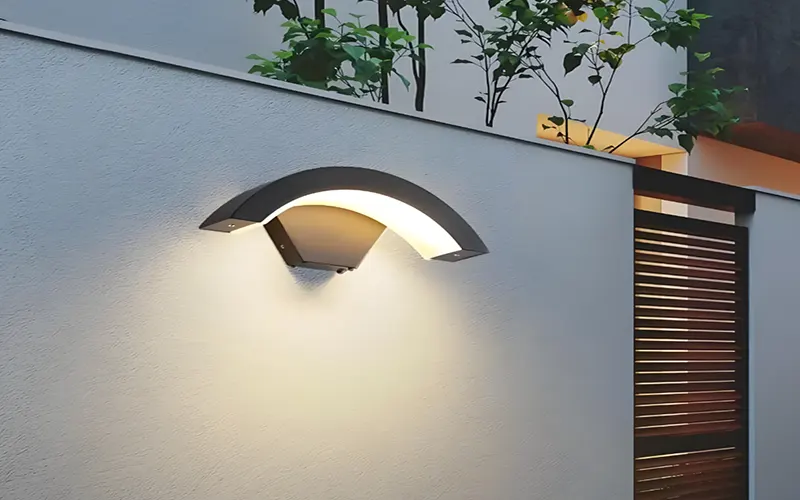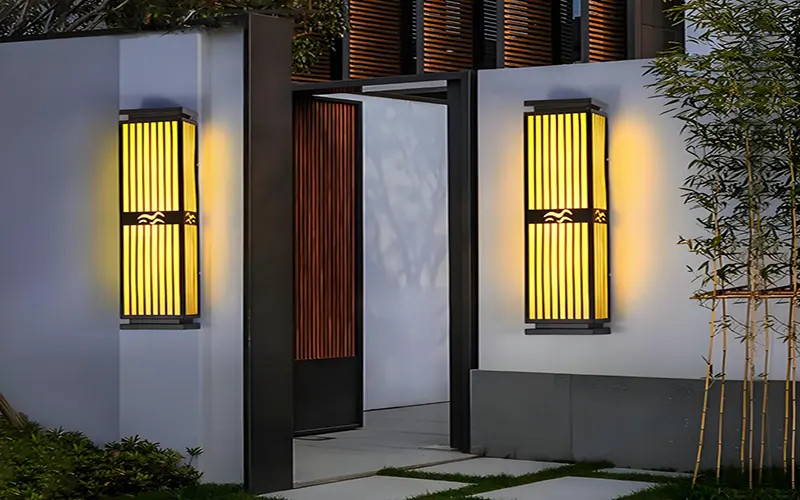Iluminat exterior este foarte importantă. Aceasta nu afectează doar frumusețea casei, ci și siguranța și funcționalitatea. Pentru luminile de perete exterioare, pervazurile ferestrelor și ușile, trebuie să alegeți luminozitatea potrivită a luminii de perete. Luminile de perete nu trebuie să fie prea slabe. Dacă sunt prea slabe, pot cauza pericole pentru siguranță. Dacă sunt prea luminoase, pot cauza poluare luminoasă sau risipă de energie. Fie că este vorba de iluminatul verandei, decorarea grădinii sau iluminatul de securitate, aplicele de perete reprezintă baza pentru obținerea unei soluții perfecte de iluminat exterior.
Tabla de conținut
De ce sunt lumenurile importante pentru luminile de perete pentru exterior?

Lumenul este unitatea internațională standard pentru măsurarea fluxului luminos total al unei surse de lumină. În termeni simpli, este cantitatea totală de lumină vizibilă emisă de o sursă de lumină. Spre deosebire de puterea tradițională, lumenii reflectă în mod direct luminozitatea reală a lămpii.
Luminile de perete pentru exterior sunt utilizate în principal pentru iluminarea ușilor, aleilor, curților, pereților și a altor zone. Valoarea lumenului adecvată poate asigura că oamenii pot vedea clar pasajele, obstacolele și mediul înconjurător pe timp de noapte și pot evita pericolele de siguranță, cum ar fi căderile și coliziunile.
Din punct de vedere practic, configurația corectă a lumenului poate asigura confortul activităților zilnice. Din punct de vedere estetic, o distribuție rezonabilă a luminii poate evidenția caracteristicile arhitecturale. Un iluminat prea puternic va produce strălucire și va afecta vecinii și pietonii.
De câte lumeni are nevoie o lampă de perete pentru exterior?
Cerințele de lumeni ale luminilor de perete pentru exterior variază în funcție de scenariul de aplicare și trebuie să le analizăm în funcție de diferite scenarii și utilizări.

Iluminatul verandei și al intrării
Pentru verande și intrări, de obicei sunt necesare aplice cu 800-1200 lumeni. Această luminozitate asigură faptul că vizitatorii pot vedea clar plăcuța ușii și treptele, fără a fi prea orbitoare.
Un alt aspect este că, pentru o verandă acoperită, poate fi selectată o valoare lumen mai mică, în timp ce o intrare deschisă necesită o luminozitate mai mare.
Curte și grădină
Lumini de perete în curți și grădini oferă un iluminat decorativ relativ moale, iar 300-600 lumeni sunt de obicei suficienți.
Iluminarea acestor scene creează în principal o atmosferă, iar o lumină prea puternică va distruge stratificarea peisajului nocturn.
Dacă această lampă de perete trebuie să ia în considerare și siguranța traficului, aceasta poate fi mărită în mod corespunzător la aproximativ 800 de lumeni.
Iluminarea garajelor și a aleilor
Lămpile de perete pentru iluminatul garajelor și aleilor necesită 1000-1500 lumeni pentru a asigura siguranța intrării și ieșirii vehiculelor și a lucrărilor de întreținere pe timp de noapte.
Dacă aleea este lungă sau lată, pot fi necesare mai multe lămpi, iar lumenul unei singure lămpi poate fi redus corespunzător.
Fațada clădirii
Iluminarea de accent a peretelui clădirii este reglată în funcție de dimensiunea și distanța obiectului iluminat, în general între 500-1500 lumeni.
Cu toate acestea, suprafața tridimensională a acestei clădiri trebuie să ia în considerare unghiul fasciculului și distanța de proiecție pentru a asigura efecte de iluminare uniforme și naturale.
Cum se calculează necesarul total de lumeni pentru luminile de perete pentru exterior?

În primul rând, trebuie să confirmăm locul de instalare și apoi să determinăm parametrii de bază ai zonei de iluminare. Măsurați zona care urmează să fie iluminată, inclusiv lungimea, lățimea și dimensiunile specifice ale oricăror forme neregulate.
Acordați o atenție deosebită înregistrării înălțimii locației de instalare, care afectează în mod direct acoperirea și distribuția intensității luminii.
Materialul de bază al solului este, de asemenea, important. Solul închis la culoare va absorbi mai multă lumină și va necesita o putere lumen mai mare.
- Pasul 1: Determinați suprafața zonei de iluminare
De exemplu, doriți să iluminați o zonă de verandă care are 5 metri lungime și 2 metri lățime, cu o suprafață de 10 metri pătrați. - Etapa 2: Standarde de iluminare de referință
Iluminarea recomandată pentru iluminatul general exterior este de 20-50 lux, iar iluminatul de securitate poate fi de până la 100 lux. - Pasul 3: Calculați numărul total de lumeni necesar
Utilizați formula:
Lumeni totali = suprafață × iluminarea necesară
Dacă iluminarea țintă este de 30 lux, atunci:
10㎡ × 30 lux = 300 lumeni
Dacă acesta este scenariul pe care îl presupunem, veți avea nevoie de cel puțin o aplică de perete de 300 de lumeni pentru a vă satisface nevoile de iluminat sau de două corpuri de 150 de lumeni fiecare pentru a distribui uniform luminozitatea.
Cum se distribuie luminile în cazul în care există mai multe lămpi de perete pentru exterior?
Distribuirea uniformă a lumenilor este cea mai comună strategie, care este potrivită pentru scene precum coridoarele și pereții care necesită iluminare generală. Cu toate acestea, este important să rețineți că distanța dintre lămpi trebuie să fie rezonabilă pentru a evita alternanța evidentă între lumină și întuneric.
Distribuiți uniform cererea totală de lumeni către fiecare lampă pentru a asigura uniformitatea iluminării în întreaga zonă. De exemplu, un perete lung de 20 de metri necesită un iluminat total de 6.000 de lumeni și sunt instalate 6 lămpi, fiecare cu 1.000 de lumeni.
Alocarea funcțională este, de asemenea, o metodă de ajustare a distribuției lumenului în funcție de cerințele de utilizare ale diferitelor zone. În principal la intrare și în locațiile canalelor cheie, trebuie utilizate lămpi cu lumen ridicat. Alte zone decorative utilizează lumeni mai mici.
Alți factori care afectează lumenul lămpilor de perete pentru exterior
Atunci când alegem lumini de perete în aer liber, pe lângă atenția acordată zonei de iluminare și nevoilor, alți factori vor afecta, de asemenea, alegerea lumenilor:
1. Temperatura culorii (Kelvin)
Alegerea temperaturii de culoare este, de asemenea, foarte importantă, deoarece temperatura de culoare afectează percepția luminii și ideile oamenilor. În general, este 2700K-3000K lumină albă caldă, care este mai potrivită pentru iluminatul rezidențial.
O alta este lumina albă naturală 4000K-5000K, care este potrivită pentru zonele funcționale și nevoile de siguranță. Cu cât temperatura de culoare este mai mare, cu atât pare mai luminoasă vizual.
2. Înălțimea de instalare a luminilor de perete în aer liber
Dacă corpul de iluminat exterior de perete este instalat mai sus, distribuția luminii va fi mai largă, dar atenuarea luminozității va fi mai evidentă și vor fi necesare lumeni mai mari pentru a compensa.
3. Unghiul fasciculului de lumini de perete
Fascicul îngust (<90°): Iluminare focalizată (cum ar fi plăcile ușilor, treptele).
Fascicul cu unghi larg (>120°): Acoperă o suprafață mare (cum ar fi o grădină).
În plus, culoarea peretelui, ocluzia plantelor, reflectivitatea etc. vor afecta percepția reală a luminozității.
Concluzie
Alegerea unei lumini de perete adecvate pentru exterior depinde în principal de zona de iluminare, de temperatura culorii și de scena de instalare, precum și de combinația de decorare și aplicare practică. Prin înțelegerea conceptului de bază al lumenului luminii de perete, a metodei de calcul al cererii reale, a principiului distribuției multi-lumină și a factorilor de influență, puteți controla cu precizie luminozitatea întregului spațiu exterior. Pentru mai multe informații despre luminile de perete pentru exterior, vă rugăm să contactați-ne.
Întrebări frecvente
Temperatura de culoare afectează percepția lumenului lămpilor de perete?
Da, răspunsul este da. Temperatura de culoare ridicată pare de obicei mai strălucitoare vizual, în timp ce lumina albă caldă este mai moale și mai confortabilă. În general, 2700K-3000K este recomandat pentru scene rezidențiale.
Temperatura de culoare afectează luminozitatea lămpilor de perete pentru exterior?
Da. Temperatura ridicată a culorii (cum ar fi lumina albă rece 6000K) pare mai strălucitoare și mai clară, potrivită pentru zonele funcționale; temperatura scăzută a culorii (cum ar fi lumina caldă 3000K) este vizual mai moale și potrivită pentru iluminat decorativ sau de dispoziție.
Pot combina lămpi de perete cu lumeni diferiți?
Da! Trebuie să ne uităm la locația instalației. Dacă intrarea principală utilizează 700-1000 lumeni (iluminare de accent), iar lămpile de perete de lângă cărare, atunci ar fi mai bine să utilizați doar 200-300 lumeni (lumină decorativă). Și acordați atenție temperaturii de culoare atunci când se potrivește (cum ar fi selectarea 3000K pentru toate).
